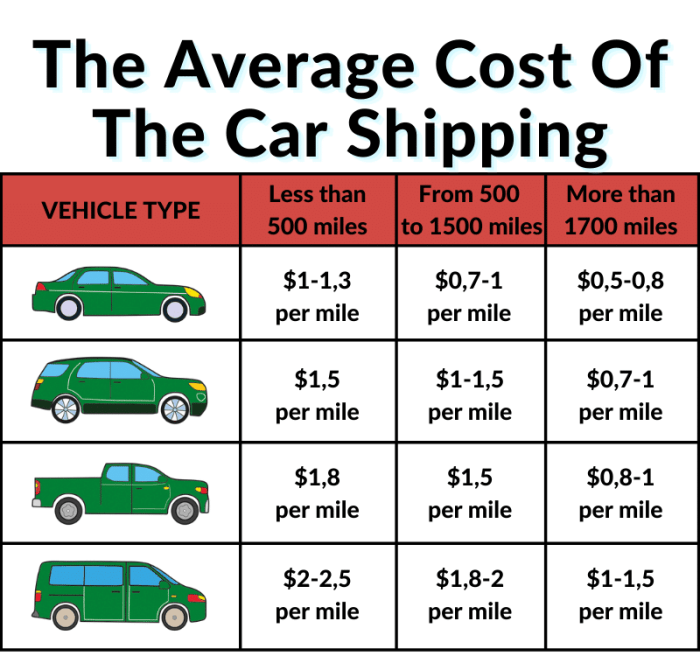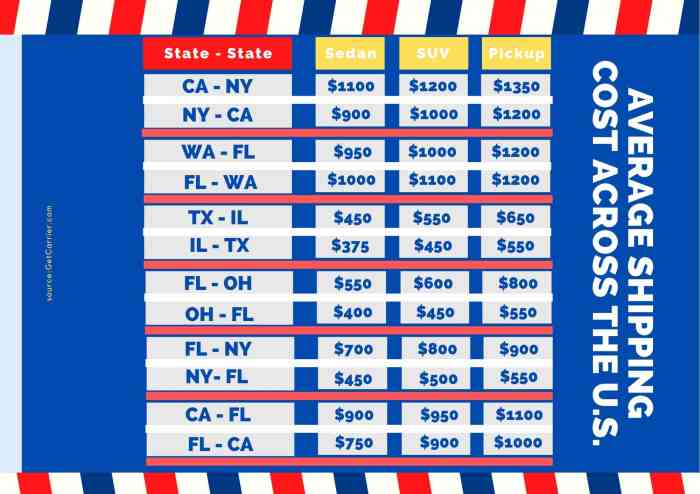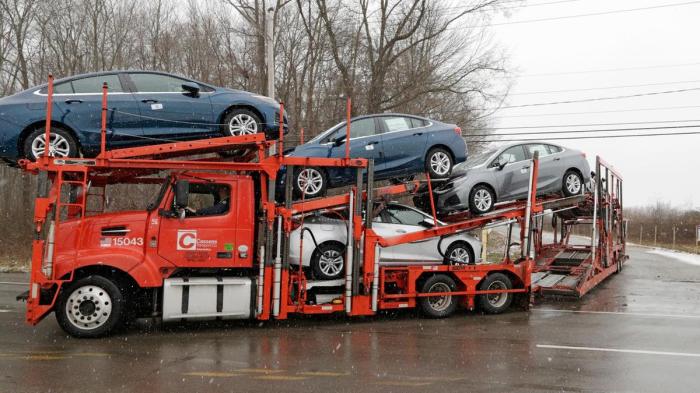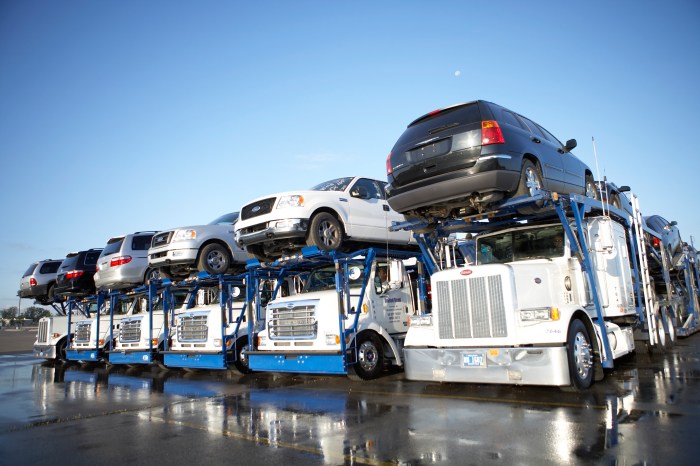Factors Affecting Car Shipping Costs
Several key factors influence the final price you’ll pay for car shipping. Understanding these elements allows for better budgeting and realistic expectations throughout the process. This section details the most significant cost drivers, providing clarity on what contributes to the overall expense.
Distance and Location
The distance your vehicle needs to travel is a primary determinant of cost. Longer distances naturally translate to higher fuel consumption and driver expenses. Geographical location also plays a crucial role; shipping to or from remote areas often incurs additional fees due to increased transportation time and logistical complexities. For instance, shipping a car from New York City to Los Angeles will generally be more expensive than shipping it from New York City to Philadelphia due to the significantly greater distance.
Similarly, shipping to a remote location in Montana might cost more than shipping to a major city like Denver due to accessibility and logistical challenges.
Vehicle Type and Size
The size and type of your vehicle directly impact shipping costs. Larger vehicles, such as SUVs, trucks, or oversized classic cars, require more space on the carrier and therefore cost more to transport. The weight of the vehicle is also a significant factor. Heavier vehicles increase fuel consumption and wear and tear on the transport equipment. For example, shipping a small sedan will typically be cheaper than shipping a large pickup truck.
Furthermore, vehicles requiring specialized handling, like those needing enclosed transport for protection, will incur additional charges.
Insurance Coverage
Insurance is an essential aspect of car shipping, protecting your vehicle against damage or loss during transit. The cost of insurance is typically included in the overall quote but varies based on the level of coverage selected. Higher coverage options offer greater protection but result in a higher premium. It’s crucial to understand the extent of coverage provided by the shipping company and to consider the value of your vehicle when choosing an insurance level.
Choosing a basic insurance plan might save a few dollars upfront, but it leaves you with greater financial risk in case of an accident during transport.
Fuel Surcharges and Other Fees
Fuel costs are a major expense for shipping companies, and these fluctuations are often passed on to the customer through fuel surcharges. These surcharges can vary significantly depending on current market prices. Beyond fuel, other fees can impact the total cost. These might include terminal handling fees, administrative charges, and any extra services requested, such as expedited shipping or door-to-door delivery.
For example, a sudden spike in gas prices could lead to a significant increase in the fuel surcharge, directly affecting the final quote. Similarly, requesting specialized handling or enclosed transport will add to the overall cost.
Seasonal Demand and Market Conditions
Shipping costs can fluctuate based on seasonal demand and overall market conditions. Peak seasons, such as summer vacation periods, often see higher demand, leading to increased prices. Conversely, during periods of lower demand, you might find more competitive rates. For instance, shipping a car during the summer months, when many people are relocating or taking vacations, is likely to be more expensive than shipping during the off-season.
Economic factors, like overall fuel prices or availability of transport, can also affect shipping costs, leading to price increases or decreases.
Finding and Comparing Quotes
Securing the best price for your vehicle transport requires diligent research and comparison of quotes from various providers. This process involves exploring different avenues for obtaining quotes and strategically evaluating the offers to ensure you receive the most competitive pricing and reliable service. Understanding the nuances of quote comparison is key to a smooth and cost-effective car shipping experience.
Obtaining car shipping quotes can be done through several methods, both online and offline. Online resources provide a convenient and efficient way to compare numerous quotes simultaneously. Many dedicated car shipping websites allow you to input your vehicle details and shipping requirements to receive instant quotes from multiple carriers. Offline methods involve contacting individual car shipping companies directly via phone or email.
This approach can be beneficial for establishing personal connections and negotiating terms, but it’s generally more time-consuming than online comparison.
Methods for Obtaining Car Shipping Quotes
Several avenues exist for acquiring car shipping quotes. Online quote comparison platforms aggregate quotes from various providers, facilitating a side-by-side comparison. Directly contacting individual carriers allows for personalized service and potential negotiation. Using a car shipping broker can streamline the process, but may involve additional fees. Finally, checking with auto dealerships or relocation services can provide access to specialized shipping arrangements.
Tips for Comparing Car Shipping Quotes
Effectively comparing quotes necessitates a systematic approach. Consider factors beyond the base price, such as insurance coverage, delivery timeframes, and the provider’s reputation and customer reviews. Verify the licensing and insurance of each provider to ensure legitimacy and protection. Avoid selecting solely on price; prioritize reputable providers with positive feedback and comprehensive service offerings. Comparing quotes based on a standardized set of parameters (distance, vehicle type, delivery date, etc.) ensures a fair and accurate evaluation.
Step-by-Step Guide to Requesting a Car Shipping Quote
Requesting a quote is a straightforward process. Begin by gathering essential information about your vehicle (make, model, year, VIN) and shipping details (origin, destination, preferred delivery date). Next, use online platforms or contact carriers directly to provide this information and request a quote. Carefully review each quote received, paying attention to all included and excluded services. Finally, compare quotes and select the provider that best meets your needs and budget.
Checklist of Questions for Potential Car Shipping Providers
Before committing to a car shipping provider, asking clarifying questions is crucial. This ensures a clear understanding of the service and avoids potential misunderstandings. A comprehensive checklist helps ensure all critical aspects are addressed.
- What is the total cost, including all fees and taxes?
- What type of insurance coverage is included?
- What is the estimated delivery timeframe?
- What is your company’s licensing and insurance information?
- Can you provide references or customer testimonials?
- What is your process for handling potential damages or delays?
- What is your cancellation policy?
- What methods of payment do you accept?
Understanding Quote Components

Deciphering a car shipping quote can feel like navigating a maze, but understanding its components is crucial for making an informed decision. A clear understanding of what’s included and excluded will help you compare quotes effectively and avoid unexpected costs. This section breaks down the typical elements of a car shipping quote, explains common terminology, and illustrates how to calculate the total cost.
Car shipping quotes typically include several key elements. These components are often presented in a detailed breakdown, offering transparency into the pricing structure. It’s important to carefully review each item to ensure you fully understand the services offered and any potential additional charges.
Quote Breakdown: Included and Excluded Services
A typical car shipping quote will itemize the costs associated with transporting your vehicle. Included services usually encompass the basic transportation of your car from the origin to the destination. This generally includes loading, securing, and unloading the vehicle onto the carrier. However, many companies offer additional services for an extra fee, such as enclosed transport for added protection, expedited shipping for faster delivery, or door-to-door service which eliminates the need for you to transport your vehicle to a terminal.
Conversely, excluded services may include things like insurance, fuel surcharges (which can fluctuate), and additional fees for oversized vehicles or those requiring special handling.
Common Terminology in Car Shipping Quotes
Understanding the terminology used in car shipping quotes is essential for accurate comparison. Familiarizing yourself with these terms will allow you to quickly assess the scope of services offered and the associated costs.
- Origin: The location where your vehicle will be picked up.
- Destination: The location where your vehicle will be delivered.
- Delivery Timeframe: The estimated time it will take to transport your vehicle. This is usually given as a range (e.g., 7-10 business days) and can vary based on distance, transport method, and carrier availability.
- Vehicle Type: The make, model, and year of your vehicle, which impacts pricing due to size and handling requirements.
- Transport Method: This specifies how your car will be shipped (open or enclosed carrier). Open transport is generally less expensive but exposes the vehicle to the elements. Enclosed transport provides greater protection but is more costly.
Payment Options in Car Shipping
Car shipping companies usually offer a variety of payment options to accommodate different preferences and financial situations. Choosing a payment method that aligns with your needs is crucial for a smooth transaction.
- Credit Cards: Most companies accept major credit cards, offering convenience and purchase protection.
- Debit Cards: Similar to credit cards, debit cards provide a direct payment option.
- Bank Transfers (Wire Transfers): This method offers a secure and efficient way to pay, especially for larger sums.
- Financing Options: Some companies might offer financing plans for customers who prefer to pay in installments. This is less common but may be available through specific partnerships.
Calculating Total Cost from a Sample Quote
Let’s illustrate how to calculate the total cost using a hypothetical quote. Always carefully review all charges to ensure accuracy. Hidden fees are rare but it is good practice to be aware of them.
Sample Quote:
| Item |
Cost |
| Base Transportation Fee |
$800 |
| Fuel Surcharge |
$50 |
| Insurance (Optional) |
$100 |
| Taxes (6%) |
$54 |
| Total Cost |
$1004 |
In this example, the base transportation fee is $800. Adding the fuel surcharge ($50), optional insurance ($100), and taxes (6% of the total excluding insurance, $850
– 0.06 = $51, rounded up to $54), we arrive at a total cost of $1004. Remember that this is a hypothetical example; actual costs will vary significantly based on numerous factors.
Protecting Your Vehicle During Shipping

Shipping your car can feel stressful, but taking proactive steps to protect it minimizes risks. Proper preparation before shipping and understanding your insurance options are crucial for a smooth and damage-free experience. This section details how to safeguard your vehicle throughout the transport process.
Preparing Your Vehicle for Shipment
Thorough preparation significantly reduces the likelihood of damage during transit. This involves cleaning, securing loose items, and documenting the vehicle’s existing condition. Overlooking these steps can complicate claims processes later.
- Clean your vehicle thoroughly, inside and out. This helps identify pre-existing damage and makes any post-shipment damage easier to assess.
- Remove all personal belongings from the vehicle. This prevents loss or damage to your possessions and simplifies the inspection process.
- Note and photograph any existing dents, scratches, or other imperfections. This serves as crucial documentation for insurance claims.
- Disable the alarm system to prevent accidental triggering during transport.
- Ensure the fuel tank is only about 1/4 full to reduce the risk of fuel spillage and minimize weight.
Insurance Coverage Options
Several levels of insurance coverage are available for car shipping, each offering varying degrees of protection. Understanding these options is vital in determining the appropriate level of protection for your vehicle’s value.
- Basic Coverage: This typically covers only liability for accidents involving the carrier’s negligence. It offers minimal protection for your vehicle’s damage.
- Full Coverage: This provides more comprehensive protection, covering damage to your vehicle during transit, regardless of fault, up to the vehicle’s declared value. This is the most recommended option.
- Released Value: This option offers lower premiums but significantly limits the carrier’s liability in case of damage. It is usually less than the actual value of the car.
Choosing the right insurance is dependent on your vehicle’s value and your risk tolerance. Consider the cost versus the potential financial loss if your vehicle is damaged.
Documenting Your Vehicle’s Condition
Comprehensive documentation is essential to protect your interests. Photographs and a detailed written inventory are crucial for resolving any discrepancies before and after shipment. This serves as irrefutable evidence in case of a dispute with the shipping company.
Step-by-Step Guide to Documenting Vehicle Condition
- Exterior Inspection and Photography: Begin by taking multiple photos of the exterior. Capture all sides, focusing on the tires, wheels, paintwork, and any existing damage. A photo description noting the location and type of any damage is highly recommended. Example: “Minor scratch on the front bumper, driver’s side.” Include close-up shots of existing damage.
- Interior Inspection and Photography: Photograph the interior, including the dashboard, seats, carpets, and any other features. Note any existing stains, tears, or damage. Again, detailed descriptions are important. Example: “Small tear on the driver’s seat, near the seam.”
- Mileage Documentation: Record the vehicle’s odometer reading before shipment. Take a photo of the odometer display to ensure accuracy.
- Inventory of Items Left Inside (if any): If you are leaving any items inside the vehicle (which is generally not recommended), create a detailed inventory list with photos of each item. This protects you in case of loss or damage.
- Create a Comprehensive Report: Compile all photographs and written descriptions into a single document, ideally a PDF file. This will serve as your record of the vehicle’s pre-shipment condition.
- Repeat the Process After Delivery: Upon delivery, immediately repeat the entire process. Compare the before and after documentation to identify any discrepancies.
Choosing a Reputable Shipper

Selecting a trustworthy car shipping company is crucial for a smooth and stress-free experience. A seemingly small price difference could mask significant risks, leading to delays, damage, or even outright scams. Diligent research and verification are essential steps in protecting your investment.Choosing the right car shipping company requires careful consideration and due diligence. Numerous factors contribute to a successful shipment, and selecting a reputable provider is paramount to ensure your vehicle arrives safely and on time.
Failing to do so can lead to significant financial and emotional distress.
Identifying and Avoiding Fraudulent or Unreliable Companies
Fraudulent car shipping companies often employ deceptive tactics to lure unsuspecting customers. These tactics can include unrealistically low quotes, high-pressure sales techniques, and requests for upfront payments exceeding industry standards. Legitimate companies will typically request a deposit, but never the full amount upfront. Be wary of companies that lack a physical address, use only temporary email addresses, or have inconsistent contact information.
Thorough research and verification are essential to avoid falling victim to these scams. For example, a company with a vague business address or one that changes frequently should raise immediate suspicion. Similarly, an inability to provide verifiable licensing and insurance information should be a major red flag.
The Importance of Checking Reviews and Ratings
Before committing to a car shipping company, thoroughly review online feedback from previous customers. Reputable platforms like the Better Business Bureau (BBB), Yelp, and Google Reviews offer valuable insights into a company’s reputation and reliability. Pay attention to both positive and negative reviews, looking for patterns or recurring issues. A high volume of negative reviews, especially those detailing damaged vehicles, missed deadlines, or poor customer service, should be a significant cause for concern.
For instance, consistent complaints about poor communication or unresponsive customer service could indicate a lack of professionalism and reliability. Conversely, a company with a history of positive reviews and satisfied customers is a strong indicator of reliability.
Verifying a Car Shipping Company’s Licensing and Insurance
Confirming a company’s licensing and insurance is a critical step in ensuring legitimacy and protecting your interests. Most states require car shipping companies to hold appropriate licenses and insurance coverage. You should request proof of both, including the company’s USDOT number (for interstate shipments) and their insurance policy details. Contacting the relevant state agency to verify the license is also advisable.
This verification process adds an extra layer of security, ensuring that the company is operating legally and is financially responsible for any potential damages or losses during transit. For example, a lack of USDOT number for interstate transport is a serious breach of regulation and should disqualify the company.
Red Flags to Watch Out for When Reviewing Car Shipping Quotes and Companies
Several red flags should prompt further investigation or cause you to reconsider a car shipping company. These include:
- Unusually low quotes significantly lower than competitors.
- High-pressure sales tactics or demands for immediate payment.
- Lack of a physical address or inconsistent contact information.
- Inability to provide proof of licensing and insurance.
- Negative or overwhelmingly negative online reviews.
- Vague or unclear terms and conditions in the contract.
- Unwillingness to answer questions or provide detailed information.
- Poor communication or lack of responsiveness.
These warning signs, when taken seriously, can help you avoid potentially problematic car shipping companies and ensure a successful and worry-free experience. Remember, a slightly higher price from a reputable company is often a worthwhile investment compared to the potential costs associated with a fraudulent or unreliable shipper.




